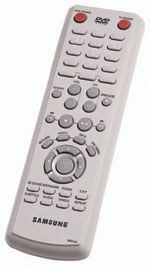Samsung DVD-HD931 Upconverting DVD Player Page 2
The player's DVI output signals are optimal for fixed-pixel displays of 720 x 480, 1,280 x 720, or 1,920 x 1,080. If your TV's native format doesn't match one of these specs, it will "rescale" the picture to make it come out right, a process that's akin to upconversion and prone to many of the same artifacts.
| HIGH POINTS Superb video quality. Easy to set up and use. Inexpensive. LOW POINT Slow cueing. |
 Hooking up the conventional outputs was also simple. Here, you select whether the component-video output carries a progressive-scan or interlaced signal and then choose either the coaxial or optical digital audio output to send the multichannel signal to the surround processor in your receiver or preamp.
Hooking up the conventional outputs was also simple. Here, you select whether the component-video output carries a progressive-scan or interlaced signal and then choose either the coaxial or optical digital audio output to send the multichannel signal to the surround processor in your receiver or preamp.
Video performance was uniformly excellent from all of the HD931's video outputs, even the lowly composite-video feed! Of course, the component output in progressive-scan operation as well as the DVI connection provided the best picture quality (the enormous number of scan lines in 1080i operation produced as smooth and filmlike an image as the progressive formats). The Faroudja DCDi technology used in the progressive processing provided excellent image quality, free of major conversion artifacts, including the infamous chroma-upsampling "bug" that can cause smearing effects on the edges of objects with highly saturated colors, especially reds.
The player was fully equal to the signal demands of the enormously entertaining Chicago, whose very dark and theatrically spotlit images are totally in keeping with the story's black humor - not least about the murderous aspects of show business. Dark scenes in any movie, but especially those here, are difficult to reproduce on any system, since you need an excellent TV that is properly set up (see "in the lab" for details on setup). Once the monitors I was using were properly adjusted (with the help of the S&V Home Theater Tune-Up disc), Chicago looked as rich in texture and detail as the several theatrical screenings I've seen. But this was subject, of course, to the limitations of the disc's MPEG encoding quality, which could be better. The DVD-HD931 certainly had no trouble decoding it, even the processing-intensive final dance sequence.
If you want a DVD player that can provide state-of-the-art image quality at a very reasonable price, and if your TV has a DVI input or is capable of progressive-scan display - or you have one like that on your Christmas wish list - the Samsung DVD-HD931 is, to use a Chicago-like turn of phrase, a very attractive proposition.
PDF: In the Lab
- Log in or register to post comments






























































